Vol 2 No. 9 TROPIC LIGHTNING NEWS March 6, 1967
Index
Gen. Weyand Leaves 25th Division
Gen. Tillson Commands
Maj. Gen. Fred C. Weyand, who watched the 25th Infantry Division
grow from the sands of Hawaii to the jungles of Vietnam, handed over the
division command to Maj. Gen. John Tillson III during ceremonies at division
headquarters last week.
Maj. Gen. Tillson comes to the 25th after serving as former
Assistant Chief of Staff, Operations, at MACV.
Gen. Weyand, who commanded the 25th for more than two and a half
years, said it had been a privilege to wear the "Tropic Lightning" patch.
The general joined the 25th in 1964. The division got the
call for Vietnam the first months of 1966.
Gen. Weyand led the division in operations Circle Pines, Santa Fe,
Fresno, Fairfax, Ft. Smith, Wahiawa, Ewa, Lanikai, Ala Moana, Fargo, Attleboro,
Cedar Falls, Gadsden and many others.
"Operation after operation has reflected your growing skill in
jungle warfare," the general said last week. "As I bid you farewell, I
commend each of you for the outstanding contribution you have made to the Tropic
Lightning division and more importantly to your country and the cause of
freedom."
Gen. Weyand began his Army career as a 2nd Lt. with the ROTC prior
to his graduation from the University of California. He was called to
active duty late in 1940 with the 6th Coast Arty. Refit.
In 1943 he was assigned to the War Dept. for special schooling and
then overseas for intelligence work in Burma and India. In 1945 Gen.
Weyand was assigned to Hq., China Theatre, in Chunking, where he served in an
intelligence capacity until the end of the war.
After World War II, he returned to the War Department as head of
the Military Branch of the Army Intelligence Service.
In 1952, the general headed an instructor group teaching regimental
tactics at the Army Infantry School and in 1954 he was assigned to the staff of
the Secretary of the Army. From 1958 to 1960, Gen. Weyand was assigned to Berlin where
he commanded the 3rd Battle Group, 6th Inf., for a year and a half and then saw
duty as assistant to the U.S. Commander, Berlin.
His next assignment as Chief of Staff, U.S. Army Europe,
Communications Zone, in Orleans, France, was followed by orders to Washington,
D.C., in 1961 for duty as Legislative Liaison. He served there for three
years until August 22, 1964 when he assumed command of the 25th Inf. Div. at
Schofield Barracks, Hawaii.
Maj. Gen. Tillson also began his Army career in 1938 when he
graduated from the United States Military Academy, was commissioned a 2nd Lt.
and was assigned to the 1st Cav. Div., at Fort Bliss, Tex.
At the outbreak of World War II he took command of the 8th Cav. at
Fort Bliss, and later the 12th Cav. at Fort Ringgold, Tex.
In 1942, Gen. Tillson was ordered to the 95th Inf. upon its
activation at Camp Swift, Tex., where he took command of the division
reconnaissance troop. In April of 1943 he was assigned as Operations
Officer of the 42nd Inf. Div. He served with the 42nd in Europe in the
campaigns of Ardennes-Alsace, Rhineland and Central Europe, ending the war with
the division at Salzburg, Austria.
In July of 1945 he was ordered to Vienna, Austria in command of the
first United States battalion to enter the city. While in Vienna, Gen.
Tillson commanded the 242nd Inf. Regt.,. the 1st Bn., 5th Inf., and the 1st Bn.,
16th Inf.
From early 1953 to mid-1954, Gen. Tillson commanded the 2nd Armored
Cav. at Nurnberg, Germany. Then he returned to the states to attend the
Army War College, from which he was graduated in 1955.
Gen. Tillson was then ordered to the office of the Deputy Chief of
Staff for Military Operations, Department of the Army. In 1958 he was
assigned to the Joint Staff, Department of Defense, where he served one year in
the Civil Affairs Directorate and one year as Special Assistant to the Director,
Joint Staff.
In 1960, Gen. Tillson was ordered to the 8th Army in Korea where he
served as operations officer for the I Corps (Group). He returned again to
the states in 1961 to become Senior Army Advisor at the Naval War College.
In January 1966, Gen. Tillson served as Operations Officer for MACV.
23,000 Swarm War Zone C
In Operation 'Junction City'
More than 23,000 Americans swarmed over the vast jungles of War
Zone C in Operation "Junction City," the latest allied effort to destroy
Viet Cong elements in Tay Ninh Province.
The operation began February 22 after the completion of Operation
"Gadsden." At week's end, allied forces, including two brigades from
the 25th Inf. Div., had formed a giant "horseshoe" formation north of Tay
Ninh which almost touched the Cambodian border. Mechanized units were
sweeping through the area.
The operation has been highlighted by the first United States major
combat parachute assault of the Vietnam war.
Paratroopers of the 173rd Abn. Inf. Bde. jumped into Katum, less
than 7 km from the Cambodian border.
The first combat parachute jump since the Korean War was made by
the 2nd., 503rd Abn. Inf.
As reports of the action started to arrive into II Field Force, Lt.
Gen. Jonathan 0. Seaman, overall commander of the operation, announced that
initial enemy opposition was scattered and U.S. casualties were very light.
Two battalions of Vietnamese Marines have been flown in to support
the operation. Details of their commitment have not been announced.
The 12th Combat Avn. Gp. supported the operation with a total of
249 Army helicopters. Five helicopters were downed by enemy ground fire
during the opening days of action.
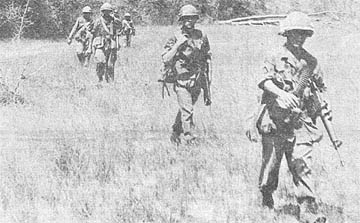 |
THRUST - Units of the 2nd Bde., 25th Inf. Div., march northward into the open "Horseshoe" formation of Operation "Junction City." (Photo by PFC Larry Craig) |
13 VC Slain Near Bong Son
Units of the 3rd Brigade Task Force and the 1st Cav. Div.
(Airmobile), continued Operation "Pershing" north of Bong Son.
Military spokesmen reported 13 enemy killed during light, scattered
actions in the operation area on the plains, 20 km north-northwest of Bong Son.
Units continued to locate and destroy caves and tunnels and other
enemy hiding places. An element of the 1st Cav. Div. received several
rounds of enemy small arms fire while on perimeter guard at English Airfield.
There were no friendly casualties and enemy casualties were unknown.
Since Operation Pershing began on February 12, 235 enemy have been
killed, 260 persons detained and 83 individual and five crew-served weapons
seized. Strike pilots have flown 185 sorties in support of the combined
ground-air operation. Friendly casualties were reported as light.
Other actions in the Central Highland Region of Vietnam, uncovered
an enemy arms and equipment cache in a native hut. The find occurred when
a company of the 3rd Brigade Task Force, a part of Operation "Sam Houston,"
swept through an area of Kontum Province, 57 km west of Pleiku City.
The cache included three 60mm mortars, four light machine guns and
large quantities of assorted ammunition and equipment. No friendly
casualties were reported.
Manchu Units Repel Wave Attack
Two platoons of Co. A, 4th Bn., 9th Inf., "Manchu" killed 92
Viet Cong last week, spoiling an estimated battalion-sized enemy unit from
overrunning their position, 500 meters south of Phu Hoa Dong village.
One Viet Cong was taken prisoner and two more detained for
questioning.
The assault, which was later termed as "human wave," began at
approximately 12:30 a.m. when the enemy poured in mortar, rifle grenade and
machinegun fire from several positions surrounding the platoons' perimeter.
The VC fired more than 100 mortars.
The two platoons were conducting a routine mission providing
security for units of the 65th Engrs. repairing a road which leads through the
Filhol Plantation and past the village of Phu Hoa Dong.
Using Chicom Assault rifles, carbines and machine guns, the enemy
force, 300 strong, charged the camp while the Manchumen fought from their bunker
positions. The first wave fell to the claymore mines and machinegun fire,
but were quickly reinforced.
Enemy bodies later found inside the camp perimeter and just a few
feet from the bunkers, gave evidence to the closeness of the enemy attack.
Several machetes, and packets of narcotics were found on the ground near the
enemy bodies.
Artillery rounds from the 7th Bn., 11th Arty., landed within 25
meters of the camp perimeter warding off the brunt of the attack. Gunships
from the 25th Avn. Bn., and the 116th Avn. Co., also lent support to the battle.
Contact was finally broken at 1:15 a.m. when two platoons of
reinforcements from the 3rd Sqdn., 4th Cav., and a platoon of Manchumen from Co.
B, arrived on the scene. Air strikes were called in on the fleeing enemy.
The action also netted captured documents, medical supplies, small
arms ammunition and grenades.
Cong Free 2/27 Sergeant
Two American soldiers, one of them a member of the 2nd Bn., 27th
Inf., "Wolfhounds," reportedly released from Viet Cong captivity more than
two weeks ago, walked into an American outpost about 56 km north of Saigon last
week, a military spokesman announced.
The spokesman said that Wolfhound Sgt. Sammie W. Womack of
Farmville, Ga., and PFC Charles E. Crafts of North Jay, Me., were in reasonably
good condition, although both suffered from malnutrition.
Radio Hanoi announced more than two weeks ago that the two soldiers
had been released on February 7, in observance of the Chinese lunar New Year (TET).
No immediate explanation was offered as to why it took them so long
to return to American hands.
Sgt. Womack was with the 2nd Bn., 27th Inf., at the time of his
capture on October 7, 1966, near Cu Chi. PFC Crafts, an advisor with the
33rd Vietnamese Ranger Battalion, was taken prisoner by the Viet Cong on
December 19, 1964 at Binh Gia.
Failure of the two Americans to show up within a few days of their
reported release urged American military authorities to publicly question the
Hanoi reports.
Radio Hanoi replied that they had released the two Americans in an
area north of Saigon along with 10 South Vietnamese soldiers.
There was no immediate report concerning the fate of the South
Vietnamese soldiers supposedly released along with the two Americans.
Page 2 TROPIC LIGHTNING NEWS March 6, 1967
Decorated
| SILVER STAR | |
| Sgt. Douglas A. Dolbin, Co. A, 4th Bn., (Mech), 23rd Inf. | Sp4 William H. Wallace, HHC, 2nd Bn., 27th Inf. |
|
DISTINGUISHED FLYING CROSS |
|
|
Capt. Peter J. Barrett, Co. A, 25th Avn. Bn. |
|
|
BRONZE STAR MEDAL (VALOR) |
|
|
Maj. Masanori M. Miyagishima, 25th MI Det. SFC Raymond D. Childress, Btry. B, 2nd Bn., 77th Arty. SSgt. Jimmie R. Deering, Btry. B, 2nd Bn., 77th Arty. |
SSgt. Jessie J. Robinson, Btry. B, 2nd Bn., 77th Arty. Sgt. Charles W. Wilson, Btry. B, 1st Bn., 8th Arty. Sp4 Douglas J. Sullivan, HHC, 2nd Bn. (Mech), 22nd Inf. (Posthumously) |
|
ARMY COMMENDATION MEDAL |
|
|
Sp5 John C. Makar, Btry. B, 3rd Bn., 13th Arty. Sp5 David A. Nordeen, Co. B, 25th Avn. Bn. Sp5 William Reinhart, HHC, 2nd Bn., 27th Inf. Sp5 Edward G. Rooney, 15th PI Det. Sp5 Thomas R. Trimble Jr, HHC, 2nd Bn., 27th Inf. Sp5 George Weeks, HHC, 2nd Bn., 14th Inf. Sp5 John A. Zasadny, HHC, 2nd Bde. Sp4 J. A. Blackstock, HHC, 25th Inf. Div. Sp4 James L. Conley, HHC, 2nd Bn., 14th Inf. |
Sp4 Everett Davis, HHC, 2nd Bn., 27th Inf. Sp4 Richard H. Feldan, Hq & Co. A, 725th Maint. Bn. Sp4 Larry G. Flick, HH&S, 3rd Bn., 13th Inf. Sp4 Kenneth J. Fox, HHC, 2nd Bn., 14th Inf. Sp4 Paul D. Hall, HHC, 2nd Bn., 14th Inf.. Sp4 Charles J. Jesuit, HH&S, 3rd Bn., 13th Arty. Sp4 Ralph D. June, Co. B, 25th Avn. Bn. Sp4 John E. Keeney, HHC, 25th Inf. Div. Sp4 Robert L. Lyles, HHC, 2nd Bn., 14th Inf. |
|
PURPLE HEART |
|
|
2nd Lt. Ronald B. Benton, Co. A, 1st Bn., 27th Inf. Sgt. Wendell Pike, HHC, 1st Bn. (Mech), 5th Inf. Sgt. Frank Sovinsky Jr., Co. A, 1st Bn. (Mech), 5th Inf. Sp4 Robert Anderson, Co. C, 4th Bn. (Mech), 23rd Inf. Sp4 Edward Davis, HHC, 1st Bn., (Mech), 5th Inf. Sp4 Edward L. Katz, Co. C, 1st Bn. (Mech), 5th Inf. PFC Louis Ferguson, Co. C, 1st Bn. (Mech), 5th Inf. PFC Mikel D. Foster, Co. A, 1st Bn. (Mech), 5th Inf. |
PFC Hugh R. Hamilton, Co. A, 2nd Bn. 14th Inf. PFC Melvin L. Lindsey, Co. A, 1st Bn., 27th Inf. PFC David J. Michael, Co. C, 1st Bn., 27thn Inf. PFC Raymond Mockabee, Co. C, 4th Bn. (Mech), 23rd Inf. PFC Jarosian Schelach, Co. C, 4th Bn. (Mech), 23rd Inf. PFC John H. Williams, Trp. D, 3rd Sqdn., 4th Cav. PFC Glenn L. Wimbish. Co. C. 1st Bn. (Mech). 5th Inf. |
McNamara Outlines U.S. Objectives
To Congress, Requests $12.9 Billion
In presenting a $12.9 billion request to Congress for new
obligational authority to supplement the FY '67 military budget, Defense
Secretary McNarnara has outlined the full range of American policy objectives
and activities in Vietnam.
His statement underscored that our overall policy objective in
South Vietnam is a stable and independent government free of external control
and externally inspired violence.
"Our immediate objective is to influence the North Vietnamese to
move the conflict from the battlefield to the conference table, or to compel
them to desist in their aggression," he continued.
Mr. McNamara's statement contained a full exposition of current
operations in Vietnam. He included these highlights:
Confirmed VC strength in South Vietnam at the close of 1966 was
about 280,000, of which 45,000 are regular North Vietnamese personnel.
South Vietnam's regular force at year's end was about 320,000
with the force level going up to 730,000 counting various militias and national
police force.
American military strength at the end of 1966 broke down into
383,000 in South Vietnam, 35,000 in Thailand and 36,000 aboard offshore ships.
Allied military strength from five nations - but principally
Republic of Korea - was 53,000 at year's end.
The VC appeared to have lost about as many men as they were able to
infiltrate from the north during the last half of 1966.
Limiting factor on VC infiltration rate depends not on mobilization
potential but on numbers of men the enemy is able to support in the south.
About 1000 fighters and attack aircraft, including carrier planes,
are deployed in Southeast Asia, with the force level to remain essentially the
same.
Air attacks on the North have destroyed two-thirds of POL storage
there.
Rate of air ordnance expended almost equals World War II peak rate
and is, in fact, four times more than the peak Korean War rate.
Navy offshore fleet will be maintained at current 90-ship level,
which does not include 26 Coast Guard boats and 84 Swift boats in "Market
Time" operations.
The Defense Secretary also noted that the four military services
had to increase their force levels above the original FY 67 budget to sustain
operations in Vietnam and to maintain a training and rotation base. These
year-end overages were given as 220,500 for the Army, 2440 for the Marine Corps,
25,520 for the Navy and 45,240 for the Air Force.
Editorial
Added Armament
Possessing the most modern and efficient weapons and equipment
known; superbly trained by skilled, dedicated leaders, the men of our Armed
Forces today are better prepared to combat enemies of our way of life than ever
before.
But weapons and training are not enough. Each fighting man must
also be armed with determination, confidence and dedication. These
additional factors guide and govern the behavior of the serviceman in combat.
They are the foundation for the Code of Conduct of the U.S. fighting man.
The Code is a reflection of the lives, deeds and valor of the
Americans who have faced the horrors of war in every conflict in which this
Nation has engaged.
The Code is built with individual faith in our Nation and upon each
individual's knowledge of the fundamental precepts of our democratic system
and institutions. It is held together with pride in service and respect
for national, military and unit history and traditions.
Encompassing all this is the determination to defeat our
country's enemies no matter what hardships must be overcome; and the
dedication to pay whatever price necessary to safeguard our country.
These are the things that have, throughout our history, made our
Armed Forces the finest in the world and have stirred our men, despite
overwhelming odds, to defend a position or gain an objective; given them
strength to survive the harsh treatment of POW camps with honor and dignity,
care for their fellow prisoners and make miraculous escapes. They have
faced death bravely and with honor, firm in the belief their cause is just.
Citizen-soldiers and professionals alike have given meaning to the
words, "I am an American fighting man. I serve in the forces which guard
my country and our way of life. I am prepared to give my life in their
defense." (AFNB)
Gen. Westmoreland Praises Viet Forces
In Report of Accomplishments in 1966
Gen. W.C. Westmoreland, commander of the U.S. Military Assistance
Command Vietnam (MACV), recently told the press that Vietnamese, American and
other Free World Forces proved their effectiveness against the enemy during
1966.
He noted that they have gained confidence in operating in a
difficult environment against the enemy and improved their tactics and
techniques, and he stressed the continuing major role of the Vietnamese armed
forces, who still carry the heaviest burden of the fighting.
"It is significant," he said, "that last year the Government
of Vietnam lost 14,000 men killed or missing in action while her allies lost
nearly 6000. Also last year there were only one-third as many South
Vietnamese soldiers missing in action, presumed captured, as in the previous
year."
He added that GVN forces lost only one-half as many weapons to the
enemy as in 1965.
The general cited these figures on progress:
The enemy lost at least 50,000 killed during 1966, a 55 per cent
increase over 1965; more than 20,000 VC or VC-sympathizers returned to the
Government of Vietnam under the Chieu Hoi program, almost twice the figure for
1965; friendly forces captured 20,000 enemy weapons in 1966, nearly twice as
many as in 1965.
Gen. Westmoreland said that the enemy expanded his military
structure in 1966 to include division-size units.
"We believe that he now has in South Vietnam in being, or in
process of formation, nine divisions, seven of which are North Vietnamese
Army," he said. Year-end enemy strength totaled 280,000.
The enemy placed increased reliance on North Vietnamese Army (NVA)
units, particularly in I and II Corps and to some extent in III Corps, the
general added, noting that the infiltration rate for the year averaged more than
8000 a month.
The general said the enemy completed equipping his forces with a
modern family of weapons -a pistol, sub-machinegun, sniper rifle, carbine,
assault rifle, light machine gun, and heavy machinegun. Most of these are
Communist Chinese copies of Soviet weapons. All use 7.62 ammunition.
The enemy inventory, also includes three rocket-launchers (B-50,
B-40, 3.5), three recoilless rifles (57mm, 75mm, 82mm), and four mortars (60mm,
81mm, 82mm, 120mm).
Gen. Westmoreland noted that the enemy's use of new weapons has
now required him to provide new ammunition as well as replacements for losses,
and pointed out that the air campaign against North Vietnam had impeded the flow
of such supplies and equipment to the south.
"There can be no doubt that many Vietnamese, American, Korean,
Australian and New Zealand troops are alive today because of the air campaign
against military targets," he said.
Gen. Westmoreland cited a number of figures to show the progress
made in 1966 in improving the logistical system. Items: 30 percent more
roads are open than a year ago; there are now nine jet-capable airfields
compared with three in December 1965; 73 C-130 fields are now operational,
compared with 15 last year; and five deep draft and seven shallow draft ports
now, compared with two deep draft and five shallow draft ports then.
In supply tonnage, POL capacity, ammunition storage space, and
items of supply, increases ranging from 200 to 500 percent were cited.
The general concluded his summary by commenting that while enemy
objectives had not changed in 1966, the military strategy of North Vietnam did
change.
"This change was the positioning of major North Vietnamese Army
units in the Demilitarized Zone and along the Cambodian Border of the central
highlands," he said.
The TROPIC LIGHTNING NEWS is an authorized publication of the 25th Infantry Division. It is published weekly for all division units in the Republic of Vietnam by the Information Office, 25th Infantry Division, APO San Francisco 96225. Army News Features, Army Photo Features, Armed Forces Press Service and Armed Forces News Bureau material are used. Views and opinions expressed are not necessarily those of the Department of the Army. Printed in Tokyo, Japan, by Pacific Stars and Stripes.
Maj. Gen. John Tillson III . . . . . . . Commanding General
Lt. Col. J. L. Aiken . . . . . . . . . . . . . . Information Officer
Capt. John P. Fortner . . . . . . . . . . . . Officer-in-Charge
Sp4 David L. Kleinberg . . . . . . . . . . Editor
Sp4 Adrian E. Wecer . . . . . . . . . . . . Editorial Assistant
Sp4 John R. Dittmann. . . . . . . . . . . . Editorial Assistant
Page 3 TROPIC LIGHTNING NEWS March 6, 1967
Two-Week Job
65th Enqrs. Blow Up VC Hq.
Enough dynamite to destroy a 20-story. building was detonated in
the mountains north of Pleiku to demolish an enemy headquarters found in Binh
Dinh Province by the division's 3rd Brigade.
Army engineers spent two weeks and used 69 tons of TNT destroying t
h e headquarters located in natural caves on a mountainside. The caves
twisted through 30-ton rocks, past hundreds of exits and into rooms large enough
in some places to hold 120 men.
Destruction of such natural fortifications is a difficult enough
job in peacetime. Under the combat conditions which Co. D, 65th Engr. Bn.,
had to work, it was nearly a miracle that they accomplished their mission.
"I've never had a harder job and I've never done anything
I've been more proud of," said 2nd Lt. Donald R. Nance, 27, the engineer in
charge. "And I think everyone who was up there feels the same way."
The only way the caves could be blown was from the inside out by
meticulously planting huge quantities of explosives in key weak points and
natural faults in the cave's structure. If the cave itself could not be
blown, then at least the entrances could be sealed.
A force of 39 engineers and parts of Co. B, 1st Bn., 14th Inf., set
out one morning recently to blow the caves. "Chinooks" hauled the
explosives when they could get low enough to drop them, but the infantry and
engineers hauled most of it on their backs. Each man had to make about 500
trips half-way up a 50 degree slope carrying 10 pounds of dynamite plus his
combat gear . . . all in two weeks.
"I've got nothing but admiration for these boys," Lt. Nance
said. "They've got great stamina and a lot of spirit. The morale
got higher as the going got rougher."
After the caves were searched' and stripped of anything of value,
the engineers moved in, positioned their charges, cleared the area and blasted.
Then they moved to the next room. The engineers set off a total of 12
blasts averaging more than five and a half tons per explosion.
At the end of two weeks the engineers were tired men, but the North
Vietnamese Army and the Viet Cong in the area were temporarily without a home.
Safer Underground Navigation Is Sought;
Mine Detectors Used in Tunnel Running
Cave-in! A tunnel rat is cut off underground somewhere 200
meters east of a too-small entrance! What can be done?
Cave-ins, boobytraps, and being cut off by the enemy have always
been the greatest fear of the tunnel rat, the daring soldier who explores Viet
Cong tunnels. Through the combined efforts of the 65th Engr. Bn., and the
men of the 2nd Bn., 27th Inf., these emergencies may soon be solved.
The answer to these problems, it seems, is the mine detector.
Traditionally used to clear roads for troop and vehicle movement, the
instruments may well have a new use in locating the exact position of tunnel
rats deep underground.
"One detector will penetrate three to four feet; not deep enough
for the average tunnel," said engineer 1st Lt. James Jenkins of Blackstone,
Va. "By using one detector in the tunnel and one on the surface we can
penetrate eight or more feet," he continued.
The magnetic fields set up by the two detectors strike each other
when one is directly over the other. The result is a beeping tone in the
headsets of both operators.
"If they work as expected we should be able to keep track of
exactly where the tunnel runner is at all times," said 2nd Bn., 27th Inf., Co.
A, commander, Capt. David A. Pabst of Rockville, Md. "This will allow us
to dig directly down to the man should he become trapped or meet a difficult
obstacle," he explained.
Tunnel navigation is now done by taking compass readings at all
bends in the tunnel and counting steps taken. The method gives only a
general fix on the man underground.
Testing of the system continues.
"We have a lot of work to do before we are certain of the
detectors," said Lt. Jenkins, "but it looks now as if they will be very
effective."
The trial runs for the system were carried out recently near Phu
Hoa Dong, northeast of Cu Chi.
| TRACING - Tunnel rat of the 2nd Bn., 27th Inf., enters a tunnel, to be followed by a mine detector. (Photo by 1st Lt. A. R. Karel) | 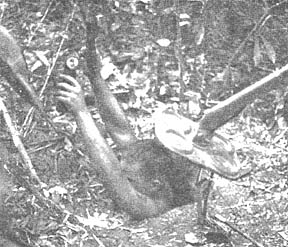 |
Dau Tieng Battle Action Nets Silver Star for 2 Wolfhounds
Two members of the division's 1st Bn., 27th Inf., were, recently
awarded the Silver Star by Maj. Gen. Fred C. Weyand, division commander.
The two were Capt. Richard B. Cole, Co. A commander, and Sp4
Richard J. Siebel, a radio operator for Co. C.
They were awarded the medals for their part in the battle of Dau
Tieng during Operation "Attleboro" last November. Capt. Cole's
Silver Star was his second award of the medal.
Capt. Cole was in command of Co. A going to reinforce Co. C, which
was pinned down by numerically superior VC forces in reinforced bunkers.
He maneuvered his company through murderous enemy fire to the left of the
beleaguered sister unit and directed action by scampering from place to place
through the barrage of bullets.
The following day, Capt. Cole's company led the march in pursuit
of the enemy.
After marching 300 meters into the dense jungle his company was
attacked with heavy automatic weapons mounted in bunkers. During the rest
of that day, and part of the next, his company withstood six human wave assaults
without giving ground.
It was Capt. Cole's personal words of encouragement that kept his
men holding on until their heavy firepower convinced the VC to withdraw.
Specialist Siebel was radio operator in Co. C, which was pinned
down by heavy VC fire. Although wounded slightly early in the encounter,
he refused evacuation to be with his commander.
When the company commander was fatally wounded, Specialist Siebel
carried him to a more secure area and began first aid.
As soon as a helicopter landed to evacuate the wounded, Specialist
Siebel carried his commander to the chopper through heavy sniper fire. The
helicopter was shot down during take-off and Specialist Siebel again made the
round trip through the heavy fire to retrieve his commanding officer.
Specialist Siebel stayed on the radio, giving the battalion
commander accurate and timely appraisals of his company's situation throughout
the rest of the day.
1 /14th Uses Own Language in VC Propaganda Center
While on a night ambush, an element of Co. B, 1st Bn., 14th Inf.,
"Golden Dragons" of the 3rd Brigade, spotted North Vietnamese Army regulars
trying to leave a huge rock formation known as "Dragon Caverns" in the early
morning darkness.
While killing two and driving the rest back into the cave, the
infantrymen found a large enemy propaganda center, equipped with propaganda
leaflets and broadcast equipment.
Lt. Roger L. Wray of Texas City, Tex., SSgt. Thomas Dean of
Jacksonville, Fla., Sp4 Charles Cato of Brooklyn, N.Y., and PFC William Bryan of
Tifton, Ga., searched the entrance of the rock complex.
One enemy was spotted and quickly downed by Lt. Wray's .45
caliber pistol. After making sure the entrance of the cave was secure, the
search continued.
The squad found large quantities of printing paper and leaflets
printed in the cave. Also, there were radios, musical instruments,
lighting equipment and a public address system. The squad also captured 30
VC uniforms and large quantities of the black cloth used in making the uniforms.
Page 4-5 TROPIC LIGHTNING NEWS March 6, 1967
196th Bde. in Action on Operation 'Gadsden'
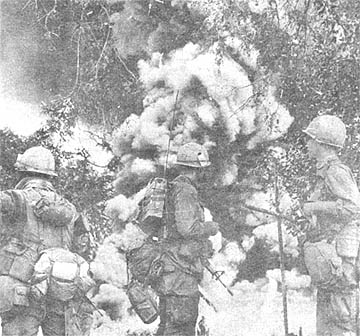 |
WHERE THERE'S SMOKE - Infantrymen of the 196th look on as a VC oil cache goes up in smoke during Operation "Gadsden" in Tay Ninh Province. |
| FIRE IN THE HOLE - A soldier of the 196th Lt. Inf. Bde. prepares to drop a hand grenade down a well used to conceal a Viet Cong tunnel. | 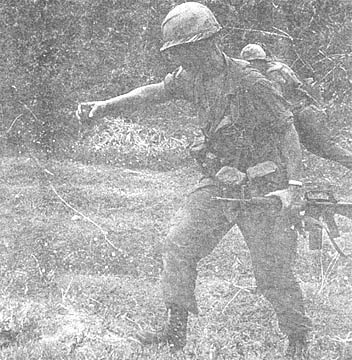 |
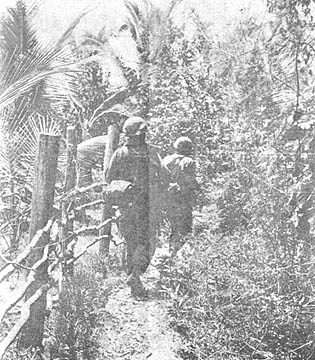 |
SEARCHING - Ever on the alert for booby traps and ambushes infantrymen search for the Viet Cong in Tay Ninh Province during Operation "Gadsden." |
| WAITING - During a break in a search and destroy mission a machinegunner and his assistant wait for further orders. | 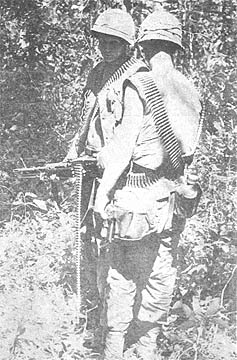 |
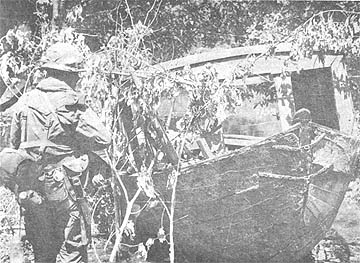 |
SAMPAN - A soldier of the 196th Lt. Inf.
Bde. approaches a
lightly camouflaged sampan used by the VC to move supplies on the waterways of
Tay Ninh Province.
|
Page 6 TROPIC LIGHTNING NEWS March 6, 1967
2-9th Fires 200, 000th
Lt. Col. Bruce Holbrook, commander of the 2nd Bn., 9th Arty.,
"Mighty Ninth," fired the 200,000th round that the artillery battalion has
sent on its way since its arrival in Vietnam.
The ceremony took place recently at Btry. B, nearly 13 months after
Gen. William C. Westmoreland, commander of U.S. forces in Vietnam, fired the
first round of the "Mighty Ninth" to be fired in Vietnam by any artillery
unit of the 25th Inf. Div.
At the recent ceremony, the executive officer of the battery, 1st
Lt. William H. Farmer Jr., of Fayetteville, N.C., loaded the round into the gun
which Col. Holbrook later fired.
Trang Bang Villagers Get Bossie Gift
The Vietnamese lunar New Year provided a fine opportunity for
United States forces to repay the many kindnesses shown them by the civilian
population in the areas of their operations. The division's 1st Bn., 8th
Arty., found a unique gift for their friends in Trang Bang - a cow.
Originally the brainstorm of the battalion's civil affairs
officer, Capt., James W. Lew, the idea soon became so popular that the men of
the Trang Bang based battery wasted no time in making it a reality.
The men decided the cow - a valuable commodity in rural areas -
should go to the 14-man colony of blind persons at the Trang Bang, Cao Dai
Temple, 35 km northwest of Saigon.
The blind are totally dependent on the brothers of the temple and
donations to the church. They plan to use the cow to raise calves for
market and for the usual milk producing qualities.
Ceremony was the order of the day as the cow was presented to the
brothers at the temple. Capt. Nghiep, the Trang Bang district chief, was
there representing local government as was Capt. James F. Gabelman, commanding
officer of Btry. A. On hand to take charge of the bovine gift was Mr. Le
The Hieu, representing the association of the blind.
Battalion's History Written in Heroic Deeds
By Sp4 John Bertak
When the commanding officer of the unit now known as the 1st Bn.,
14th Inf., asked Gen. George G. Meade, commander of the Army of the Potomac,
where his unit would march in the grand review at the close of the civil war,
the general replied, "To the right of the line, where they've always
been!"
These words have since symbolized the fighting spirit of the
battalion and are now inscribed on the unit's crest.
During the 1906 Boxer Rebellion in China a young private named
Calvin P. Titus, who later attained the rank of colonel, was serving with the same
unit. History was again written when the late Col. Titus volunteered to
scale the wall of the enemy's castle. His famous reply of "I'll try
Sir! " has since been an inspiration to many American soldiers. For his
gallant actions, Col. Titus was awarded the Medal of Honor.
In appreciation of the unit's heroic actions in subduing the
rebellion, the Chinese people honored the battalion by presenting it with a
dragon, the ancient Far Eastern symbol of power. The unit was also awarded
the name "Golden Dragons," and a gold dragon sits atop a replica of the
famous castle on the unit crest.
F r o m the Spanish-American War through the Korean War the
battalion distinguished itself as a courageous unyielding fighting unit.
In January of 1965, the battalion again returned to the Far East,
this time to the Central Highlands of South Vietnam.
Men, like SSgt. Jessie L. Harris of Centralia, Wash., are again
displaying the courage for which the battalion is famed. Under intense
enemy fire, Sgt. Harris crawled through the open to aid one of his wounded
comrades lying in the open. Although wounded himself before reaching the
soldier, Sgt. Harris continued on to the man, administered first aid to him, and
dragged him back to a spot out of the enemy's line of fire. Sgt. Harris
then returned to the same location and again exposed himself to direct enemy
fire while going to the aid of another wounded man. Although hit by enemy
fire a second time, the sergeant continued until he reached the second man and
began aiding him. It was at this point that Sgt. Harris received his third
and fatal wound. For his courageous actions, the young sergeant was
posthumously awarded the Silver Star.
Many of the men of the battalion have served almost a year in
Vietnam and will be going home soon. Many will remember the day, in the Ia
Drang Valley when Sgt. Ralph E. Williams crawled 50 meters under enemy fire to
aid and bring back a wounded comrade lying directly in the line of enemy fire.
Sgt. Williams was awarded the Bronze Star Medal for his courageous
act.
When asked about his heroic deed, Sgt. Williams replied that it
"was just part of my job as an American soldier. I think any guy in the
unit would have done the same thing."
The battalion color of the 1st of the 14th are shrouded with more
than 30 battle streamers courageously won over the years.
Lt. Gen. Stanley R. Larsen, commanding general of I Field Force,
Vietnam, has noted that the battalion is one of the finest fighting units serving
in the Republic of Vietnam.
Not all of the men in the 1st of the 14th have been awarded Silver
or Bronze Star Medals. However, they all have earned the Combat
Infantryman Badge which marks them as American fighting men who have served
against hostile forces in combat.
65th Engrs., MPs Get New Commanders
In recent change of command ceremonies held at the division's Cu
Chi base camp, Lt. Col. A.S. Fullerton became the new commander of the 65th Engr.
Bn., and Capt. James D. Hodges assumed command of the 25th MP Co.
Col. Fullerton of Albany, N.Y., has replaced Lt. Col. Carrol D.
Strider, who had been the engineer commander since June of 1964. Col.
Fullerton entered the Army in 1949, after graduating from the United States
Military Academy. He holds the Bronze Star medal including "V" Device
with one Oak Leaf Cluster, and the Army Commendation Medal with two Oak Leaf
Clusters.
Capt. Hodges of Briarclift, Md., replaced Capt. Donald R. Keith,
who was recently assigned to the MP School at Fort Gordon, Ga. Capt. Hodges, who
holds the Army Commendation Medal and the Vietnamese Medal of Honor (First
Class), is a graduate of the University of Kansas.
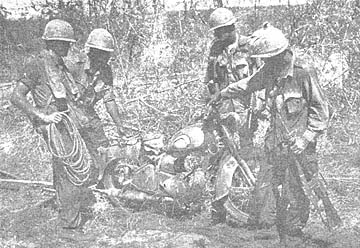 |
Hell's Angels, Tay Ninh Chapter NEEDS - "All it needs is a motor, a chain and two new tires..." Members of the 2nd Bn., 1st Inf., 196th Lt. Inf. Bde., captured this motor bike while on a search and destroy mission in Tay Ninh Province. (Photo By Chris Perales) |
1/14th Uncovers Big Arms Cache In NVA Hideout
First platoon of Co. B, 1st Bn., 14th Inf. "Golden Dragons"
continue to strike it rich. While on a recent search and destroy mission
in Binh Dinh Province, it came upon a small Montagnard village one-and-half
miles northeast of the base camp.
The Golden Dragon platoon, led by Lt. Roger Wray of Texas City,
Tex., surrounded the village and swept across it completely surprising the
inhabitants. The village sat high on the side of a mountain overlooking a
rushing stream which muffled the sound of the approaching troops.
While the villagers were being questioned by the 3rd Bde. MI Det.,
the platoon made a quick but thorough search of the area. They discovered
several caves and a large cache of American-made weapons such as Thompson
sub-machine guns, M-60 machine gun parts and 60mm mortars. They also found
several M-1 rifles, other carbines of unknown make and an NVA and Russian flag.
FAC Survives 16 Hits
Sixteen bullets riddled the OI-E "Bird Dog" aircraft of Air
Force Capt. Malvin Chubb as he circled over a trapped Viet Cong unit.
The Joplin, Mo., Forward Air Controller (FAC) was directing the
strikes of Air Force fighters southwest of Cu Chi in a recent division
operation.
Laying the tiny one-engine plane over on one side to get a better
view of the enemy below, he suddenly felt something strike his helmet.
Bits of the radio next to his right arm had flown throughout the cockpit after
the set was hit.
In the next few seconds 15 more rounds tore through the frail
observation plane. Capt. Chubb rolled the plane level and flew straight
away from where he had been hit. "I would have slowed down too much if I
had tried to circle and evade the fire," he explained, "then I would have
been a perfect target."
He flew directly back to Cu Chi, a little shaken, but completely
unharmed. "Luckily I wasn't carrying a passenger that day," he
exclaimed. The passenger seat area of the plane had been pierced by 10
rounds.
Capt. Chubb's job as FAC is to observe the battle area for enemy
movement, and to control the movements of the supersonic fighter aircraft
attacking the enemy. The jets literally fly too fast to see their target.
The FAC becomes their "eyes and ears" in directing them onto the target.
Page 7 TROPIC LIGHTNING NEWS March 6, 1967
1/35th Lieutenant Wins Silver Star
1st Lt. William H. Dalehite, of the 1st Bn., 35th Inf., "Cacti
Green" was presented the Silver Star by Maj. Gen. John Norton, commander of
the 1st . Air Cav. Div., at an awards ceremony held at the battalion's forward
command post last week.
The Army's third highest award for valor was awarded Lt. Dalehite
for heroism while serving with the Cacti Green on Operation "Paul Revere IV"
in the mountainous regions near the Cambodian border.
While operating on a search and destroy mission, Lt. Dalehite
immediately organized, maintained and directed an assault on the enemy.
In order to properly organize his assault, he exposed himself to
the heavy automatic rifle fire from the trees to his front and from the bunkers.
Discovering that two of his men were wounded and lying in an
exposed position, Lt. Dalehite took immediate action.
He personally led the platoon medic to the two wounded men and
covered their position in the process. Immediately after the wounded had
been secured, Lt. Dalehite renewed his platoon's attack at the center position
from which the heaviest enemy fire was coming.
Engineers Tear Apart VC Jungle
The heavy jungle surrounding the city of Tay Ninh has always been
well known to the Viet Cong. For years Charlie has mapped clearly in his
mind every foot of his land and has found no great difficulty in moving freely
in and out of the province.
Times are changing. Under the watchful eye of Co. C, 3rd Bn.,
21st Inf., 196th Lt. Inf. Bde., Charlie's hide-away is being remodeled.
Bulldozers from the brigade's 175th Eng. Co. are tearing a path
twice as wide as an air strip through the area, clear to the Saigon River.
By rearranging and clearing the area, the brigade will make it
vastly more difficult for the VC to move north or south unobserved, and Charlie
knows what happens to him when he is seen.
A change from the type of missions to which they are accustomed,
Co. C is surveying the operation with its security platoons, ensuring that the
VC don't disturb the landscaping project. While "Charlie's Tigers"
are not used to merely waiting for the Cong, they realize the job's
importance.
4th Div. Troops at Ambush Academy
The men from the 3rd Bde., 4th Inf. Div., sat attentively as the
instructor from the 25th Inf. Div. at Cu Chi explained small unit action in the
field.
The men, from the 1st Plt., 3rd Bn., 22nd Inf., were attending the
rigorous Ambush Academy - 16-hour-a-day, four-day class on survival and ambush
techniques.
The platoon, commanded by 1st Lt. John H. Andrews of Seattle,
Wash., was sent to the school because every man in the group had earned his CIB
while under enemy fire, and had been participants in numerous ambushes since
their arrival in Vietnam. They were also picked to attend the school
because they had scored more Viet Cong kills than any platoon in the battalion.
The academy consisted of review work on the use of the compass, map
reading, artillery support and employment of medical evacuation as well as
special emphasis on Claymore mines.
Operating as two separate units, the platoon was graded on its
procedures in actual ambushes on the final night of class.
2 Artillerymen Go Infantry With 4/31st
How many of the 412,000 American troops in Vietnam are actually
line infantrymen? How many of the rest really know anything about the job
the infantryman does, going out into the jungles and paddies and fields in
search of the Viet Cong, day after day?
Two men who were not infantry, but were curious about the
infantryman's job have done something toward finding out. PFCs James
Rodman of La Porte, Ind., and Richard Johnston of Cincinnati, Ohio, both of Btry.
C, 3rd Bn., 82nd Arty., 196th Lt. Inf. Bde. volunteered for duty as infantrymen
in the brigade's 4th Bn., 31st Inf. during Operation "Gadsden."
"I volunteered so that I could learn what the infantryman goes
through out in the field, I wanted to learn what it takes to he an
infantryman," explained PFC Rodman.
PFC Johnston admitted, "I wanted a change. I wanted to go
out on patrols, and learn the things that go into making a patrol a success."
In the field after their initial missions, the men said they'd
learned something. "It's a challenge to be out here," said PFC
Rodman. "There are so many things you have to know to get along."
One artilleryman who has been with the infantry for some time, PFC
Daniel Nidds, a radio-telephone operator (RTO), said, "I think more
artillerymen should come out to the field and go through what the infantry does.
It would be a good experience. Someday they may have to be infantrymen."
| PANTS DOWN - Sp4 George Densley of the 2nd Bn., 1st Inf., checks himself out for size with the bottom half of a pair of black pajamas found while searching a VC encampment. "Guess we caught 'Charlie' with his pants down," said Specialist Densley. | 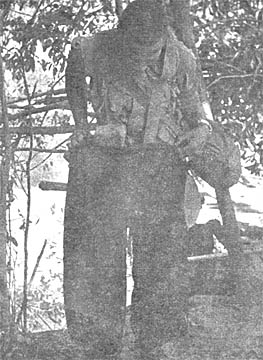 |
SMaj. Paul Nunan Becomes 25th Division's Top NCO
SMaj. Paul D. Nunan, 45, of Killeen, Texas, has become the new
sergeant major for the 25th Inf. Div., replacing SMaj. Kenneth J. Leyden who
went to the 1st Armor Div. at Fort Hood, Texas.
SMaj. Nunan, a veteran of nearly 25 years in the Army, served
during World War II in Europe. He made four combat parachute jumps, one
each in Sicily, Salerno, Normandy - where he landed just before the D-Day
soldiers hit the beaches - and one at Nijmagen, Holland.
When he landed in Nijmagen on September 19, 1944, SMaj. Nunan found
himself and his men facing the fire of a 20mm anti-aircraft cannon leveled at
them from a protected position in the city streets.
The sergeant major knocked out the gun and killed seven enemy
soldiers. For his actions, he was awarded the Silver Star for gallantry in
action. He used a British Gammon grenade, a Thompson sub-machine gun, and
white phosphorous grenades in the battle.
In the Korean War, the sergeant major served as an air operations
sergeant with the 8th U.S. Army on special duty with the 5th Air Force.
There, he was awarded the Korean Presidential Unit Citation.
Operators Gather
Officers and enlisted men from nearly all U.S. Army Vietnam's 20
MARS stations met recently at Di An to discuss the system's progress and
future development. MARS, the Military Affiliate Radio System, provides
trans-Pacific telephone and telegraph messages for American soldiers through
military radio facilities in Vietnam and MARS member stations in the U.S.
New Tennis Clinic Opens at Tay Ninh
Tennis anyone? This is a familiar phrase to the avid player,
and soon it will be heard around Tay Ninh as the sport spreads through the
province.
A tennis clinic has been started as part of the 196th Lt. Inf.
Bde.'s civil affairs program in the Tay Ninh area.
With the assistance of Lt. Lewis A. Stein of Chicago, Ill., the
program began recently when 28 candidates showed up for the first day's
activities. Lt. Stein, a former professional tennis instructor at the Don
Kerbis Tennis Club in Highland Park, Ill., received 25 tennis rackets and a
gross of balls from the club to start the tennis program.
"The purpose of the club is to stimulate interest in tennis and a
healthy attitude in sportsmanship and fair play," said Lt. Stein.
1st Sgt. Stanley Re-Ups, Takes Oath in the Field
1st Sgt. Calvin E. Stanley of HHB, 25th Inf. DivArty. recently
re-enlisted for three years. DivArty. commander, Col. Daniel B. Williams,
administered the oath in ceremonies at his forward base camp at Trai Bi on
Operation "Gadsden."
When he completes his new term of enlistment, Sgt. Stanley will
have served more than 22 years in the Army. He has served two years in the
Philippines, four years in two tours in Korea, one during the Korean War, one
short tour in Hawaii and his present tour in Vietnam.
Sgt. Stanley has held the position of NCOIC of DivArty's
adjutant's office before becoming the top NCO in headquarters battery.
5th Mech. Recon Goes James Bond
James Bond is serving with the 25th Inf.. Div.'s 1st Bn. (Mech.),
5th Inf., or so it would seem, if one were to look at the armored personnel
carriers of the reconnaissance element.
The numbers designating this element range from 001 to 007.
Each APC is given a name to correspond to the numbers straight from Ian
Fleming's novels. The APC's sport such names as "Dr. No," "You
Only Live Twice," "Goldfingers," "Moonraker," "Thunderball," and
for 007, what else, "Secret Agent."
Their primary purpose is to inspect an area before the main body of
the element enters. If there is an area suspected of harboring a VC
element or detachment, they sweep into the area and probe it, seeking to draw it
out into the open and reveal its position.
James Bond would indeed be proud to have such a unit bearing his
name.
Page 8 TROPIC LIGHTNING NEWS March 6, 1967
|
Maj. Gen. Weyand's Farewell Message |
|
|||||||||||
|
Operation after operation has reflected your growing skill in
jungle warfare, progressing from small unit sweeps to multi-brigade operations.
Operation "Attleboro" was the first of several such operations, with most of
the Division's maneuver elements taking part in the clearing of War Zone C;
others were Cedar Falls and Gadsden. In each of these operations the men
of the 3rd Brigade, 4th Division and the 196th Separate Brigade fought side by
side with us. As outstanding as these large-scale operations were, there has been no operation that could be called insignificant. Circle Pines, Santa Fe, Fresno, Fairfax, and Fort Smith; Wahiawa, Ewa, and Lanikai; Ala Moana, Fargo, and a score of others - all stand out as important, productive maneuvers. You have met the enemy on his own grounds and have beaten him. Complementing your many successful military operations has been your most energetic approach to the Division's Revolutionary Development Program. With your assistance, hundreds of Vietnamese children are now receiving an education that will inevitably strengthen their love of freedom and serve as a future bulwark against the spread of communism in Southeast Asia. You have rebuilt villages and have helped the government of Vietnam to re-establish its presence throughout the country. You have provided safety for thousands of Vietnamese families who have suffered from the violence of the terrorizing Viet Cong. You have helped to build a nation. As I bid you farewell, I commend each of you for the outstanding contribution you have made to the "Tropic Lightning" Division and, more importantly, to your country and the cause of freedom. |
|||||||||||
|
Thanks to
Arthur B. Neighbor, 228th Supply & Service Co. (Direct Support) for sharing
this issue,
Kirk Ramsey, 2nd Bn., 14th Inf. for creating this page.
This page last modified 8-12-2004
©2004 25th Infantry Division Association. All rights reserved.